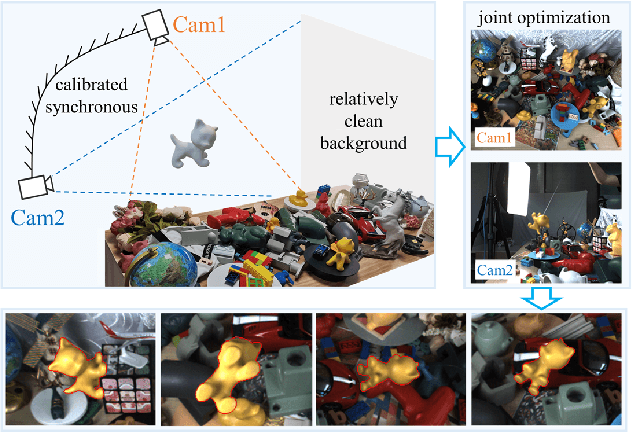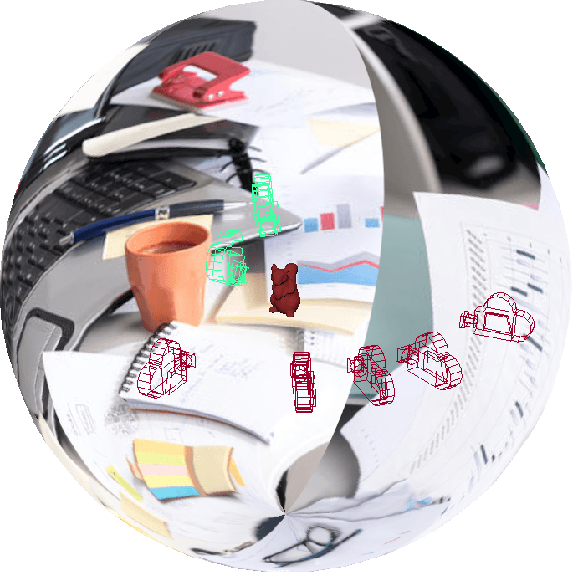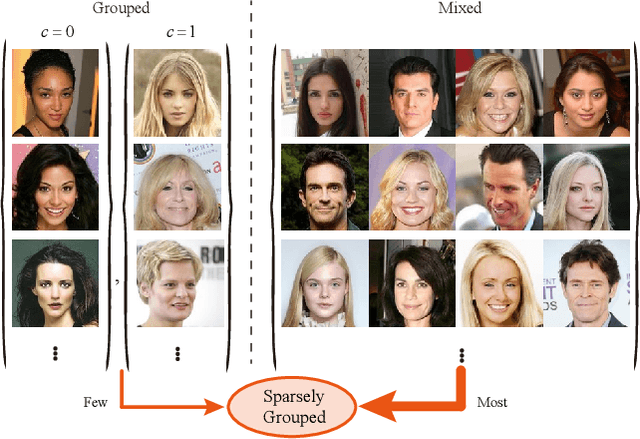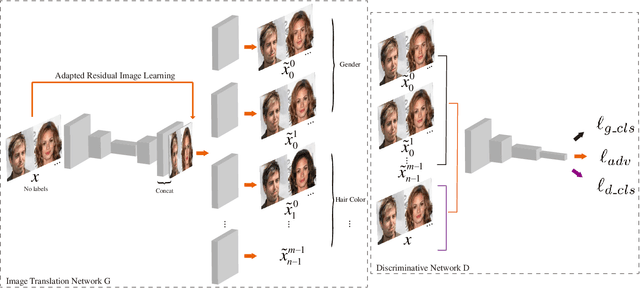Xueying Qin
For A More Comprehensive Evaluation of 6DoF Object Pose Tracking
Sep 15, 2023



Abstract:Previous evaluations on 6DoF object pose tracking have presented obvious limitations along with the development of this area. In particular, the evaluation protocols are not unified for different methods, the widely-used YCBV dataset contains significant annotation error, and the error metrics also may be biased. As a result, it is hard to fairly compare the methods, which has became a big obstacle for developing new algorithms. In this paper we contribute a unified benchmark to address the above problems. For more accurate annotation of YCBV, we propose a multi-view multi-object global pose refinement method, which can jointly refine the poses of all objects and view cameras, resulting in sub-pixel sub-millimeter alignment errors. The limitations of previous scoring methods and error metrics are analyzed, based on which we introduce our improved evaluation methods. The unified benchmark takes both YCBV and BCOT as base datasets, which are shown to be complementary in scene categories. In experiments, we validate the precision and reliability of the proposed global pose refinement method with a realistic semi-synthesized dataset particularly for YCBV, and then present the benchmark results unifying learning&non-learning and RGB&RGBD methods, with some finds not discovered in previous studies.
Guided Linear Upsampling
Jul 13, 2023



Abstract:Guided upsampling is an effective approach for accelerating high-resolution image processing. In this paper, we propose a simple yet effective guided upsampling method. Each pixel in the high-resolution image is represented as a linear interpolation of two low-resolution pixels, whose indices and weights are optimized to minimize the upsampling error. The downsampling can be jointly optimized in order to prevent missing small isolated regions. Our method can be derived from the color line model and local color transformations. Compared to previous methods, our method can better preserve detail effects while suppressing artifacts such as bleeding and blurring. It is efficient, easy to implement, and free of sensitive parameters. We evaluate the proposed method with a wide range of image operators, and show its advantages through quantitative and qualitative analysis. We demonstrate the advantages of our method for both interactive image editing and real-time high-resolution video processing. In particular, for interactive editing, the joint optimization can be precomputed, thus allowing for instant feedback without hardware acceleration.
Large-displacement 3D Object Tracking with Hybrid Non-local Optimization
Jul 26, 2022



Abstract:Optimization-based 3D object tracking is known to be precise and fast, but sensitive to large inter-frame displacements. In this paper we propose a fast and effective non-local 3D tracking method. Based on the observation that erroneous local minimum are mostly due to the out-of-plane rotation, we propose a hybrid approach combining non-local and local optimizations for different parameters, resulting in efficient non-local search in the 6D pose space. In addition, a precomputed robust contour-based tracking method is proposed for the pose optimization. By using long search lines with multiple candidate correspondences, it can adapt to different frame displacements without the need of coarse-to-fine search. After the pre-computation, pose updates can be conducted very fast, enabling the non-local optimization to run in real time. Our method outperforms all previous methods for both small and large displacements. For large displacements, the accuracy is greatly improved ($81.7\% \;\text{v.s.}\; 19.4\%$). At the same time, real-time speed ($>$50fps) can be achieved with only CPU. The source code is available at \url{https://github.com/cvbubbles/nonlocal-3dtracking}.
BCOT: A Markerless High-Precision 3D Object Tracking Benchmark
Mar 25, 2022



Abstract:Template-based 3D object tracking still lacks a high-precision benchmark of real scenes due to the difficulty of annotating the accurate 3D poses of real moving video objects without using markers. In this paper, we present a multi-view approach to estimate the accurate 3D poses of real moving objects, and then use binocular data to construct a new benchmark for monocular textureless 3D object tracking. The proposed method requires no markers, and the cameras only need to be synchronous, relatively fixed as cross-view and calibrated. Based on our object-centered model, we jointly optimize the object pose by minimizing shape re-projection constraints in all views, which greatly improves the accuracy compared with the single-view approach, and is even more accurate than the depth-based method. Our new benchmark dataset contains 20 textureless objects, 22 scenes, 404 video sequences and 126K images captured in real scenes. The annotation error is guaranteed to be less than 2mm, according to both theoretical analysis and validation experiments. We re-evaluate the state-of-the-art 3D object tracking methods with our dataset, reporting their performance ranking in real scenes. Our BCOT benchmark and code can be found at https://ar3dv.github.io/BCOT-Benchmark/.
GazeCorrection:Self-Guided Eye Manipulation in the wild using Self-Supervised Generative Adversarial Networks
Jun 03, 2019



Abstract:Gaze correction aims to redirect the person's gaze into the camera by manipulating the eye region, and it can be considered as a specific image resynthesis problem. Gaze correction has a wide range of applications in real life, such as taking a picture with staring at the camera. In this paper, we propose a novel method that is based on the inpainting model to learn from the face image to fill in the missing eye regions with new contents representing corrected eye gaze. Moreover, our model does not require the training dataset labeled with the specific head pose and eye angle information, thus, the training data is easy to collect. To retain the identity information of the eye region in the original input, we propose a self-guided pretrained model to learn the angle-invariance feature. Experiments show our model achieves very compelling gaze-corrected results in the wild dataset which is collected from the website and will be introduced in details. Code is available at https://github.com/zhangqianhui/GazeCorrection.
Sparsely Grouped Multi-task Generative Adversarial Networks for Facial Attribute Manipulation
Oct 19, 2018



Abstract:Recently, Image-to-Image Translation (IIT) has achieved great progress in image style transfer and semantic context manipulation for images. However, existing approaches require exhaustively labelling training data, which is labor demanding, difficult to scale up, and hard to adapt to a new domain. To overcome such a key limitation, we propose Sparsely Grouped Generative Adversarial Networks (SG-GAN) as a novel approach that can translate images in sparsely grouped datasets where only a few train samples are labelled. Using a one-input multi-output architecture, SG-GAN is well-suited for tackling multi-task learning and sparsely grouped learning tasks. The new model is able to translate images among multiple groups using only a single trained model. To experimentally validate the advantages of the new model, we apply the proposed method to tackle a series of attribute manipulation tasks for facial images as a case study. Experimental results show that SG-GAN can achieve comparable results with state-of-the-art methods on adequately labelled datasets while attaining a superior image translation quality on sparsely grouped datasets.
Deeply Supervised Depth Map Super-Resolution as Novel View Synthesis
Aug 27, 2018



Abstract:Deep convolutional neural network (DCNN) has been successfully applied to depth map super-resolution and outperforms existing methods by a wide margin. However, there still exist two major issues with these DCNN based depth map super-resolution methods that hinder the performance: i) The low-resolution depth maps either need to be up-sampled before feeding into the network or substantial deconvolution has to be used; and ii) The supervision (high-resolution depth maps) is only applied at the end of the network, thus it is difficult to handle large up-sampling factors, such as $\times 8, \times 16$. In this paper, we propose a new framework to tackle the above problems. First, we propose to represent the task of depth map super-resolution as a series of novel view synthesis sub-tasks. The novel view synthesis sub-task aims at generating (synthesizing) a depth map from different camera pose, which could be learned in parallel. Second, to handle large up-sampling factors, we present a deeply supervised network structure to enforce strong supervision in each stage of the network. Third, a multi-scale fusion strategy is proposed to effectively exploit the feature maps at different scales and handle the blocking effect. In this way, our proposed framework could deal with challenging depth map super-resolution efficiently under large up-sampling factors (e.g. $\times 8, \times 16$). Our method only uses the low-resolution depth map as input, and the support of color image is not needed, which greatly reduces the restriction of our method. Extensive experiments on various benchmarking datasets demonstrate the superiority of our method over current state-of-the-art depth map super-resolution methods.
Deep Depth Super-Resolution : Learning Depth Super-Resolution using Deep Convolutional Neural Network
Jul 07, 2016



Abstract:Depth image super-resolution is an extremely challenging task due to the information loss in sub-sampling. Deep convolutional neural network have been widely applied to color image super-resolution. Quite surprisingly, this success has not been matched to depth super-resolution. This is mainly due to the inherent difference between color and depth images. In this paper, we bridge up the gap and extend the success of deep convolutional neural network to depth super-resolution. The proposed deep depth super-resolution method learns the mapping from a low-resolution depth image to a high resolution one in an end-to-end style. Furthermore, to better regularize the learned depth map, we propose to exploit the depth field statistics and the local correlation between depth image and color image. These priors are integrated in an energy minimization formulation, where the deep neural network learns the unary term, the depth field statistics works as global model constraint and the color-depth correlation is utilized to enforce the local structure in depth images. Extensive experiments on various depth super-resolution benchmark datasets show that our method outperforms the state-of-the-art depth image super-resolution methods with a margin.
 Add to Chrome
Add to Chrome Add to Firefox
Add to Firefox Add to Edge
Add to Edge